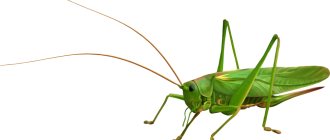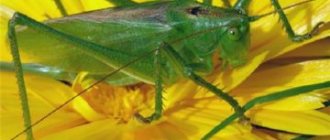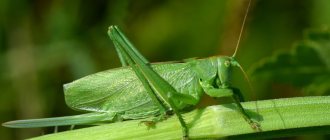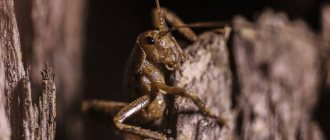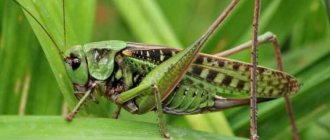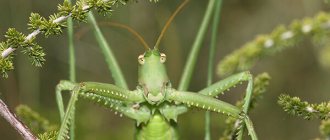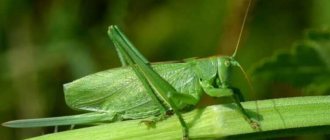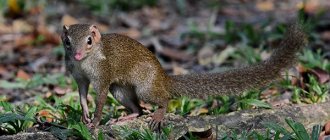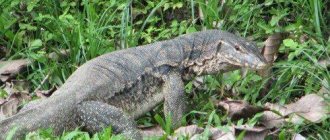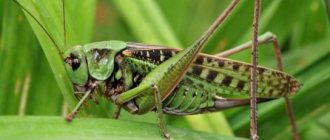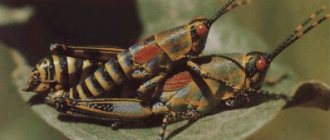The greenhouse grasshopper belongs to the family of cave grasshoppers or raphidiophorids. (Rhaphidophoridae), including 550 species. These are long-moustached orthoptera insects that have lost the ability to fly. Under natural conditions, they are found in dark, damp caves. Using a synanthropic relationship with humans, insects settle in basements, sewers, ventilation shafts, where there is always high humidity and a stable warm temperature. There is enough organic matter here that is suitable food. The greenhouse grasshopper prefers to live in greenhouses and feed on plants.
Home maintenance
Many people may think that the singing grasshopper is an excellent pet to keep at home, but actually they are right.
If you are not bothered by the fact that the pet will not live long, and will chirp without a female in a pair, then feel free to drag it home. It is not difficult to make a terrarium for a singing grasshopper; any container with sufficient ventilation, approximately 40x30x30 in size for 2-3 singing grasshoppers, will do.
It is recommended to sprinkle sawdust at the bottom of the container, and place a jar of wet peat in the corner, into which the female will lay larvae. Any substrate will do, even soil from the street, with the proviso that you will then have to look for the eggs of the singing grasshopper by hand. You should also place various driftwood and sticks in the container to increase the usable area and allow the grasshopper to climb branches.
The singing grasshopper should be fed with insects; at home, you can feed it with food insects such as marbled or Turkmen cockroaches; you should also offer greens, in the form of various plants from the street.
Song grasshopper eggs along with the substrate should be removed at the end of August and placed in the refrigerator until the end of February. Then they are removed and the little singing grasshoppers are waited for to emerge.
Control measures
Methods to combat this insect have not yet been sufficiently developed. For preventive and exterminatory purposes, the following is recommended: it is advisable to locate tobacco plantations away from egg-laying sites (thrush and virgin areas) of the green grasshopper; treatment of the shag field and surrounding area with internal poisons; placement of bait with poison in pest habitats. This will require 30–60 kg of bran, 24 liters of water, 0.8–1.2 kg of arsenous soda.
Video
https://youtube.com/watch?v=F9rC3L_y9zo
Sources
- https://www.animals-wild.ru/nasekomye/1489-oranzhereynyy-kuznechik.htmlhttps://ru.wikipedia.org/wiki/Grasshoppershttps://vdbr.ru/pevchij-kuznechik-opisanie.htmlhttps:// stopvreditel.ru/rastenij/selxoz/kuznechik-zelenyj.htmlhttps://nashzeleniymir.ru/grasshopper
Peruvian grasshopper
Opened in 2006 in the mountains of Guyana. The grasshopper imitates the color of a fallen leaf. Externally, the insect also resembles it. The outer side of the folded wings is dotted with a grid pattern. It repeats the capillary pattern on dried greenery.
In order to resemble a fox in shape, the grasshopper folds its wings, covering the sides and a large space above the back.
The underside of the wings of the Peruvian grasshopper is colored like the Peacock butterfly. She chose this design to scare away predators. Seeing “eyes” on the wings of an insect, they mistake it for a bird or other animal. The Peruvian grasshopper uses the same trick. It also bounces characteristically to resemble the head of a large bird.
The Peruvian grasshopper opens its wings and looks like a butterfly.
Grasshoppers. Survival.
Grasshoppers are food for many fauna. They fight for survival without ceasing. For this, nature has endowed them with many tools.
These include the coloring of insects and their ability to freeze in place, allowing them to blend into their environment.
They are also powerful limbs and wings that carry the insect over long distances. These are strong jaws that can even bite through human skin. In addition to the obvious ways to protect themselves, “grasshoppers” are endowed with a number of little-known tools.
These include the following.
Firstly, he, like, for example, a lizard, is capable of breaking off part of his body in case of danger.
Secondly, representatives of this species masterfully imitate the leaves and twigs of trees and shrubs, which is facilitated, among other things, by their color.
The third little-known method of defense is the squeal that the insect makes in case of danger.
The fourth method of defense of grasshoppers is regurgitation of gastric juice, as a result of which the attacker feels disgust and lags behind the potential victim.
Description and features
The grasshopper is an insect found almost everywhere. It is so hardy and unpretentious to environmental conditions that it can successfully take root in almost any corner of the vast world, with the exception of areas of the planet covered with eternal snow and bound by ice all year round. This insect is found on plains and highlands, hiding in green meadow grass; it is an inhabitant of humid, hot jungles and even arid deserts.
Grasshopper: description and photo. What does an insect look like?
Most species are distinguished by an elongated body, a laterally compressed head and two oval, faceted grasshopper eyes. Powerful gnawing jaws help the insect deal with prey and tear off pieces of food. Depending on the species, the length of a grasshopper can range from 1.5 to 15 cm.
Most grasshoppers have a back pair of legs designed for jumping. Their femurs are thickened at the base, their shins are elongated, equipped with spines and movable “spurs”. The thigh of the jumping leg is connected to the lower leg in a special way - “back with the knee”, which allows insects to jump over gigantic distances by their standards. The other two pairs of grasshopper legs are of the running type. Pushing off with enormous force, the grasshopper jumps a long distance. The length of a grasshopper's jump can be 20 times the length of its body.
The sensitive antennae of the grasshopper, which perform the function of touch, are much longer than the body in some species.
Some species of grasshoppers are endowed with two pairs of wings, used for flight and as a protective covering.
Hind leg of a grasshopper
The grasshopper's hind legs are adapted for jumping, with thick thighs and long tibiae (hence why they are called jumping insects).
The legs are attached to the chest from below, usually sit in the coxal cavities and consist of a coxa, trochanter, femur, tibia and tarsus. The coxa and trochanter provide the necessary mobility to the leg. The thigh is the largest and strongest part of the leg, as it has powerful muscles. Its articulation with the lower leg is called the knee, and the part adjacent to it is called the knee. The tibia is approximately equal in length to the thigh, but thinner, equipped with spines, and spurs at the top. Jumps can reach a height of up to 80 cm, and if wings help, the distance they cover in one jump reaches 10 meters.
Giant weta
Endemic species, found only in New Zealand. The weta weighs about 70 grams, that is, 2 times more than a sparrow. The length of a well-fed grasshopper reaches 15 centimeters. The rest of the appearance is unremarkable. The insect is colored in beige-brown tones.
The legs of the giant weta are of medium length, the eyes are of medium size, and the mustache is of mediocre length in comparison with the size of the body.
The gigantism of New Zealand grasshoppers is due to the absence of small mammals on the islands. For lack of enemies, the Wets almost reached their size. However, in the 20th century, mammals were introduced to the fields of Zealand. Because of this, the number of giant grasshoppers is declining.
Grasshopper giant weta
Flightless grasshoppers
Some grasshoppers lack wings. As a rule, these are inhabitants of fields and rocky embankments. Grasshoppers that climb trees retain their wings. However, there are species with spines on their paws. The needles, like spurs, dig into the stems, fixing insects.
Curious grasshoppers
The huge number of varieties of such insects indicates their undoubted diversity. This also applies to their appearance. Mentioning different types of grasshoppers , we have already encountered very unusual ones, for example, the leaf grasshopper or the spiny devil. But there are other, no less amazing representatives of the alluring world of small creatures. They will be discussed further.
Multicolored grasshopper
Such noticeable insects, although not capable of flight and without wings at all, are found in Colombia. But nature generously enriched them with a variety of colors, which corresponds to the nature of the area where they live.
Their body is covered with patterns of blue, red, white, as well as other numerous tones and their shades, combined into intricate patterns. Moreover, the color of the members of this variety exists in many variations. There is a subspecies with individuals that have an orange-black outfit.
Pink grasshopper
Such grasshoppers really exist. But they do not belong to any species, because they are victims of a genetic mutation, one might even say a disease. With it, the production of red pigment in the insect sharply exceeds the norm.
This cannot be considered a positive change. All grasshoppers, as we have seen, strive to be invisible, but these, on the contrary, stand out. Due to this, their chances of survival are significantly reduced. Pink specimens of grasshoppers have been recorded several times in England, as well as on islands near the Australian continent.
Peacock grasshopper
However, bright colors can play into the grasshopper’s hands. Another example of this is a variety that was discovered quite recently, just over ten years ago, and found in the tropical forests of Peru. The colors of such creatures make them look like fallen leaves. But that's not all.
They have huge wings, which they spread in moments of danger, making them look like bright butterflies. But the most important thing is the pattern on the wings. Among other designs, it has circles that exactly resemble the eyes of a bird of prey, from which any enemy comparable in size to grasshoppers will run away.
The similarity is even more intensified and becomes frightening when the grasshopper begins to jump. Such dances terrify enemies, instilling the idea that an insidious pursuer is chasing them.
Grasshopper rhinoceros
Another variety, the appearance of the representatives of which exactly copies the leaf, albeit a little withered and torn, which only adds naturalness. Here all that remains is to once again admire the perfect art of nature.
And the shape of the “leaf” is realistically similar, slightly curved. And the point sticking out in front imitates a handle, but also resembles a horn. This is where the name came from. Such grasshoppers have thin and inconspicuous, but extremely long antennae.
Giant weta
The types of grasshoppers in the photo provide an opportunity to get acquainted in detail with the external appearance of these creatures. And now it’s time to introduce the largest, and also ancient, grasshopper that exists on the planet. It is a resident of New Zealand, and is found exclusively there, that is, it is considered endemic.
Such a creature has apparently lived on Earth since time immemorial, ever since giants were not at all uncommon in the world of insects. Today, such creatures, in exceptional cases, are capable of reaching sizes of 15 cm, although not all of them are this size.
The color of the giant grasshopper can be beige-brown or brown. A distinctive feature of such insects is the presence of sharp, large spines on their hind limbs. This is a weapon for protection against enemies and a good means of obtaining food.
The antiquity and preservation of this species to this day is explained by the absence on its native islands of active enemies capable of feeding on such huge insects. And therefore, until a certain point, the giant wetas lived quietly and remained untouched.
But with the development of civilization, everything changed. People brought small mammals to the islands. Some of them spread quite widely and considered giant grasshoppers quite desirable food for themselves. Therefore, the number of unique giants began to decline. It's a pity.
How do grasshoppers reproduce?
In the tropics, the mating process lasts all year round; in other areas, mating begins with the onset of warm weather, namely from May to June.
The fertilization process occurs in the following way.
The male attaches a spermatophore, consisting of a capsule with sperm and a spermatophylax filled with a viscous substance, to the body of the female.
If the purpose of a capsule with sperm is quite clear - it is directly fertilization of the female, then the use of Supermatophylax in the process of fertilization is quite specific.
During the process of fertilization, the female eats the spermatophylax, so the seed has enough time to move into the oviduct. This increases the likelihood of fertilization of the female and the birth of offspring.
The vessel with the seed contains a special tubular process, which is inserted into the genital opening of the female. In this case, the vessel itself and the spermatophylax remain outside. Mating ends and the female begins to eat first the spermatophylax, and then the vessel that contained the seed.
Some time after fertilization, the female begins to lay eggs. The process of laying offspring lasts several hours. One clutch can contain up to 1000 eggs. At the same time, carnivorous and herbivorous grasshoppers lay them in different places. Thus, herbivores prefer to lay eggs on the surface of plants. Carnivores prefer to bury future offspring in the ground. And they lay eggs not in one place, but in different ones, in groups of 10 pieces.
For example, common platetails prefer to lay eggs in the bark of trees, bushes, and in cracks of wooden buildings. The spiny platetail lays eggs in the leaves of cereal crops. The four-spotted laminated wing lays eggs under the upper layer of the epidermis of the leaves of trees and shrubs. To do this, the female makes an incision on the leaf, inserts the ovipositor there, and lays the future offspring at the bottom of the resulting sac.
The offspring of grasshoppers begin to hatch from eggs as the weather warms up. During their life, molting, that is, shedding old skin, occurs in larvae up to 6 times and with each new shedding, the wings of grasshoppers become more and more adapted to full functioning. Between the larval phase and the adult phase there is an intermediate phase, the so-called nymph phase.
The grasshopper in this phase has already gone through several processes of shedding its skin and the last shedding awaits it, after which it is considered an adult. From all of the above, we can conclude that the only significant difference between larvae and nymphs from an adult is the presence of developed wings in the latter. This statement does not apply to two species of arthropods, namely the Malayan and Sudanese grasshoppers, the larvae of which are completely different from the adult.
What does a grasshopper eat?
For the most part, the grasshopper is a predator, mercilessly destroying clutches of insects, aphids, caterpillars, butterflies, beetles, ticks, and small locusts in its path. If you are unlucky with hunting, unpretentious insects are content with young shoots of plants. The food of some species of grasshoppers is exclusively plant-based: grasshoppers eat grass or leaves of trees (for example, birch and chestnut trees), and some of them are noted as serious agricultural pests. Unlike the same related locusts, which eat farmers' crops, grasshoppers are more beneficial. For example, they help get rid of the Colorado potato beetle, which has taken a fancy to potato fields.
In conditions of autonomous maintenance and lack of nutrients, grasshoppers have even been observed in cannibalism, that is, eating their own kind. A simple experiment showed that if you put several of these insects in a closed jar and leave them without food for a couple of days, the group will eventually suffer losses among their relatives.
It may seem surprising, but if the grasshopper does not receive its “dose” of protein and salts from ordinary food, then it does not disdain to feed on feces and carrion, and also eats its weaker relatives with appetite.
Nutrition
Among the small insects that inhabit the Earth, there are also cruel predators. Grasshoppers are one of them. These are natural, skilled hunters. They try to grab their prey with lightning speed, using their forelimbs. They feed on larvae as well as small insects, eating small locusts, mites and aphids.
Grasshoppers also eat beetles, butterflies, and caterpillars. In cases of shortage of other types of food, especially if they find themselves captive in a confined space, they are capable of attacking their own relatives in a wave.
Flowery grasshopper eating leaves
And sensing luck, the stronger will feast on the weaker with appetite, without hesitating at all. To get their required dose of nutrients, salts and protein, these insects are able to consume carrion and feces.
Grasshoppers can be attracted to plant leaves from plant food, but only on young shoots. There are species for which this type of nutrition is the main and even the only one.
However, in this case, the insatiability of grasshoppers sometimes harms cultivated and forest plants. But by eating harmful insects, in particular the Colorado potato beetle, which destroys potato plantings in huge quantities, grasshoppers turn out to be very useful.
Interesting things about grasshoppers
- These insects, thanks to their strong jaws, are able to bite through human skin. In principle, this is the only harm that representatives of this species can cause to people. The exception is a couple of varieties of grasshoppers that consume vegetation from tea and tangerine plantations, causing significant damage to farmers.
- In many countries, grasshoppers are eaten. For example, in China, in African countries, in Thailand.
- Interestingly, these insects are often kept in residential areas as pets. Several representatives of this species are placed in a transparent vessel and enjoy the chirping of these musical insects. And so that individuals do not eat each other in a confined space, they are provided with a complete diet, including fruits, vegetation, and animal food (flies, spiders).
- The most surprising fact is that some species of grasshoppers are only female. At the same time, females are able to lay eggs. But these eggs also hatch only into females.
- One common misconception about grasshoppers is that they are related to locusts. In fact, grasshoppers and locusts are completely different types of arthropod insects; they are not related. And if you want to know exactly how “grasshoppers” and “locusts” differ, you can read the article on locusts.
The largest grasshopper in the world
When we hear “grasshopper,” a character from everyone’s favorite children’s song immediately comes to mind—a cute insect with a green body and long, jumping limbs. In fact, the grasshopper is not as harmless as it might seem at first glance. He is not averse to dining on small insects, or even even entering into a fight with a frog in order to taste the tasty delicacy. And the sizes of grasshoppers of different species differ noticeably from each other.
Ueta (from Greek - “terrible grasshopper”) is how New Zealanders call amazing insects from the order Orthoptera. The body length of some representatives of the families Rhaphidophoridae and Anostostomatidae reaches 10-20 cm, and this does not include paws and antennae! The largest grasshopper in the world weighs up to 70 grams, which is approximately equal to the weight of the sparrow we all know. It is worth noting, however, that the females of this insect are significantly inferior in size and weight to the males.
Description[ | code]
General form
Head and chest close-up
Building | code
Grasshoppers are medium-sized with long thin legs and very long antennae (up to 80 mm), which are almost four times the length of the body. The body is stocky, arched, densely covered with very small hairs that form a silky coating. Wings are absent in both sexes. Body length: 11.0–13.0 mm (males, ), 14.0–18.0 (females, ); pronotum 4.5–6.0, 5.0–6.5; front leg hips 8.0–10.0, 9.2–11.0; hind leg hips 15.0–20.0, 18.5–21.5; ovipositor 18.5-21.5 mm. The main body color is yellowish-brown and gray. Antennae and legs with light rings. The femora of the fore legs have one long apical spine, and the femora of the middle legs have two such spines. Femurs of hind legs of males with 7–9 spines. Hind tibia of males with 47-66 small spines directed outward and towards the body and located in groups (the group arrangement of such small spines distinguishes these grasshoppers from the closely related genus Diestrammena
). The openings of the auditory organ on the front legs are absent.
Biology | code
Crepuscular and nocturnal insects avoid light and, for example, in greenhouses they hide during the day between boards and other objects such as flower pots. They typically feed on dead insects, organic matter and waste, and may also damage plant material such as seeds, fruits, seedlings or young leaves and flowers. In case of mass reproduction, they cause damage in greenhouses. They can jump up to 1.5 m in length and up to 0.5 meter in height. Both larvae and adult insects can be observed at any time of the year. Females lay up to 90 eggs at a time in the ground to a depth of 7-12 mm. In total, one female lays from 150 to 900 eggs during her life. The eggs are 2 mm long and 1 mm wide. The larvae (outwardly similar to the imago) hatch after 3-4 months and in 7 months go through 10-11 molts until they are fully grown. Overall, biology remains poorly understood. One generation develops per year.
Meaning | code
Greenhouse tropical and ornamental plants are damaged, including orchids (eat leaves and sprouts), cyclamen (eat shoots), chrysanthemums (eat cuttings), ferns (eat unexpanded leaves), as well as garden crops. They mainly harm succulent sprouts. To combat the pest, it is recommended to use succulent plants treated with insecticides.
They pose no direct danger to humans, are not poisonous and do not bite.
Varieties and botanical description
There are 4 types of crickets: house, field, stem and ant. Let's take a closer look at them.
Brownie
The house cricket has a gray-yellow color with brown streaks, and has 3 stripes of the same color on its head. Individuals measure up to 25mm. They have a chitinous layer that protects it from moisture loss and some environmental influences.
The antennae of these insects perform the function of touch, the two front pairs of limbs are responsible for hearing, and the two rear ones are responsible for moving by jumping.
But if there are too many insects, this will lead to great harm to cultivated plants.
Field
Basically, these crickets live in meadows and fields, but can also be found in pine forests. They live in the ground at a depth of about 20 cm.
They have dimensions close to the size of a brownie, but have a black color with a glossy tint. You can find brown individuals with orange splashes. They also have antennae and eyes.
Stem
This type of cricket has another name: “eastern trumpeter”. This species is smaller in size than its family. Their size is only about 1.3 cm, the color of the stem cricket is green, with a black stripe on the belly.
This species got its name because it lays eggs in plant stems. Each clutch contains no more than 2-3 eggs. In mid-summer, larvae emerge from the eggs, which then turn into adults.
Formic
Ant crickets are small in size even compared to their relatives. They grow to only 5 mm, have no wings, and look like cockroaches. This species cannot make sounds.
They nest next to ants and spend the winter in anthills. Their larval development cycle from egg laying is about 2 years and is divided into five stages.
Green grasshopper
Cannot be larger than 7 centimeters in length. The insect is painted green. The color on the wings is especially rich. There are 2 pairs of them. This is a feature of all grasshoppers. They use the first narrow pair of wings to protect the body when at rest and when jumping. The upper wings are wide and are used for flight.
On the wings of a green grasshopper there may be brown along the edge. Large eyes stand out on the insect's muzzle. They are faceted, that is, they are held on the head by a ring of cuticle - a tough but flexible tissue.
There are subspecies of green grasshoppers. They all hide in the crown of bushes and trees. Therefore, insects do not jump out from under people’s feet. Accordingly, meetings with representatives of the group are rare.
Adaptation of grasshoppers to their environment
Many animals feed on grasshoppers, and they face death every second. Therefore, they fight for life, using all the opportunities given by nature. The main methods of defense of grasshoppers are protective and dismembering coloration, the ability to hide, jumping legs, spines with which they signal to relatives about approaching danger, and the ability to bite. For example, the leaf grasshopper from Sudan can bite through human skin until it bleeds. But there are also lesser-known types of protection for these insects.
When threatened, some grasshoppers can tear off their legs. The ability of animals to break off body parts is called autotomy. Grasshoppers easily lose one of their hind legs, and sometimes both. Close to the phenomenon of autotomy is the process of self-mutilation - gnawing off limbs in response to irritation. This is especially common in some grasshoppers.
Protective coloring seems to be a simple and primitive way of protection. Grasshoppers also use other, more complex methods of deception. Mimicking leaves is a favorite technique used by many insects. One of the grasshoppers of the species Cycloptera elegans looks very much like a dried leaf. The similarity is enhanced by spots on its wings, reminiscent of a fungal infection of the leaves.
Another grasshopper from the genus Pterochosa, living in America, is similar in color, pattern, and arrangement of veins to a withering and discarded leaf. There are spots on its wings that resemble damage to leaves by leaf miners. This ideal method of copying was called “hyperthemia” (overimitation).
Other species imitate the resemblance to a twig protruding from a trunk, lichen growths on tree trunks. There are grasshoppers that can scare away attackers with a squeal and cause disgust with a drop of regurgitated gastric juice.
Photo credit: gailhampshire, CC BY 2.0
Notes
- (English). Orthoptera Species File (Version 5.0/5.0). Retrieved August 13, 2022.
- ↑
- ↑ Pravdin F.N.
Order Orthoptera (Orthoptera) // Animal Life. Volume 3. Arthropods: trilobites, chelicerates, trachea-breathers. Onychophora / Ed. Gilyarova M. S., Pravdina F. N. - 2nd ed., revised. - M.: Education, 1984. - P. 178-180. — 463 p. - ↑ Bei-Bienko G. Ya. Order Orthoptera - Orthoptera // Key to insects of the European part of the USSR. T. I. Lower, ancient winged, with incomplete transformation. / edited by Corresponding member G. Ya. Bey-Bienko. - M.-L.: "Science", 1964. - P. 210. - 936 p. — (Key guides to the fauna of the USSR, published by the Zoological Institute of the USSR Academy of Sciences; issue 84.). — 6300 copies.
- Stanek V. Ya.
Illustrated encyclopedia of insects. - Prague: Artia, 1977. - P. 50. - 560 p. - Striganova B. R., Zakharov A. A.
Five-language dictionary of animal names: Insects (Latin-Russian-English-German-French) / . - M.: RUSSO, 2000. - P. 16. - 1060 copies. — ISBN 5-88721-162-8. - Ilyinskaya M.I.
Pests of greenhouse plants. - M.: Publishing House of the USSR Academy of Sciences, 1963. - 131 p. - ↑ Pests of agricultural crops and forest plantations: In 3 volumes - Vol. 1. Harmful nematodes, mollusks, arthropods / Under the general. ed. V. P. Vasilyeva. Editor of the volume V. G. Dolin. — 2nd ed., rev. and additional - K.: Harvest, 1987. - P. 133. - 440 p.
- ↑ Beloselskaya Z.G., Silvestrov A.D.
Pests and diseases of flower and greenhouse plants. - M.-L.: Selkhozgiz, 1953. - P. 93, 96, 111, 114. - 208 p. - ↑
- ↑ (German). orthoptera.ch. Retrieved August 13, 2022.
- ↑
- ↑ Peter Detzel.
Die Heuschrecken Baden-Württembergs. - Stuttgart: Eugen Ulmer, 1998. - ISBN 3-8001-3507-8. - Akhatov A.K. et al.
Protection of greenhouse and greenhouse plants / edited by A.K. Akhatov and S.S. Izhevsky. - M.: KMK, 2004. - P. 84. - 307 p. — ISBN 5-87317-161-0. - Bey-Bienko G. Ya. et al.
Insects and mites are pests of agricultural crops. T. 1. Insects with incomplete transformation / ed. volumes: Kryzhanovsky O. L., Danzig E. M.. - L.: Nauka, 1972. - P. 16. - 323 p. - Adelung N.
Beitrag zur Kenntnis der palaarktischen Stenopelmatiden (Orthoptera, Locustodea) (German) // Extrait L' Annuaire Musee Zoologique L' Academie Imperiale Science St. Petersburg. - 1902. - Vol. 7. - P. 55-75. - (English). Orthoptera Species File (Version 5.0/5.0). Retrieved August 17, 2022.
Distribution area
Natural range: East Asia (China, Korea, Japan). At the end of the 19th century, this grasshopper with plants was brought to Europe and North America, where it was noted as a synanthropic species. In the European part of Russia, it was first described in 1902 from the Botanical Garden of St. Petersburg. Later it was found in Kyiv (Botanical Garden named after Academician A. A. Fomin), as well as in greenhouses in Moscow, Kirov and other cities. Under the name Tachycines coreanus Yamasaki, 1969 in 1999 it was first found in the Russian Far East in Vladivostok. In 2005, it was first found in the Middle Volga region (Penza).
In the introduced parts of the range they are found in heated and humid areas: greenhouses, greenhouses, botanical gardens, zoos, as well as sewers and basements of residential buildings, from where they can penetrate into apartments through ventilation systems. Outside their borders, in temperate countries, it is found only in hot summers. In Adjara and Georgia it penetrated into the countryside, where it is found in bathhouses, kitchens and basements.
Main news of Kaluga region
Obninsk basements are inhabited by illegal migrants - small ones, with big mustaches!
Rumors about strange insects that appeared in Obninsk spread throughout the city several years ago. And not just rumors - a photograph of a “monster” discovered in an apartment in a multi-storey building, similar to a spider, a cockroach, and a cricket, even appeared on the website of the Obninsk housing and communal services (https://gkh.obninsk.ru)!
To be honest, the information seemed suspicious. Although from the point of view of biology there was nothing impossible about it. The world of insects is generally poorly studied; dozens of new species are discovered every year (of course, mainly in tropical forests), and well-known species are often discovered in new regions - let us recall, for example, the American Colorado potato beetle, which appeared in Europe in the 20th century. Or the latest example is American cockroaches in Moscow. Globalization, fusion of cultures! Unknown and new animal species for the region are a long-standing and special interest of our informal research group. There are dozens of reports about strange animals in our archive, for example, about combed snakes in the endless swamps of the north-west of Russia or spiders the size of a basket in the deep forests of the Caucasus... But still, for something like this - nearby, in a big city - is too simple and prosaic ...
Attempts to confirm or refute the rumors over the phone led to nothing - all kinds of plumbing and plumbing authorities only stated that they were not interested in exotic insects - there were enough other things to do. However, during personal conversations upon arrival in Obninsk, we were able to obtain little more information.
“Yes, there were such rumors,” said A. Puzankov, head of the department of preventive disinfection of the city Central State Emergency Service, “as well as about mutant rats... But I can’t say anything reliable. We do not have entomologists on our staff. Besides, we are talking about the basements of residential buildings? In recent years, we have not been working with the housing stock; management companies have entered into agreements with other institutions. So if applications from residents sometimes arrive, we are forced to redirect them...
There was only one thing left to do - to go through the city housing departments (now known under the newfangled name “the managers here knew little: “our plumbers, if they see something strange, still won’t tell us - so that they won’t be mistaken for drunken people.” And rightly so) “We’ll accept it, but we won’t believe it.” And yet, it was in the office of the management company on Gorky Street that our first eyewitness was found:
“I saw them with my own eyes,” said Tatyana Yamshchikova. – But not here, but... in the kitchen of my apartment on Marx Street. This is a completely different part of the city. I live on the first floor of a dorm, and at the end of last year they often appeared in the common kitchen. They're jumping right on the floor. Like grasshoppers, and their whiskers are long. Maybe crickets? I don't understand them.
Well, let's go even lower and talk to those who climb through basements as part of their job.
In the very center of Obninsk, in the basement of a five-story residential building, the plumbers of Construction Company LLC are based. Here the well-known Russian paradox was fully manifested: in contrast to the incurious and often afraid to speak bosses, the “proletarians” communicate willingly, know much more and show genuine interest in the issue:
“Yes, such creatures have appeared in the basements,” those sitting at the table in the “duty room” said vying with each other. – usually where it’s warmer and damper. Like grasshoppers, only they jump on the ceiling. Both small and matchbox-sized. It's been about five years since they've been caught. Need it? How many to catch? What size? We don’t know where they came from. We were already discussing - somehow we suddenly began to come across more and more often...
The manager's plumbers were no less talkative:
– There are a lot of evil spirits living in the basements. There are jellyfish, or whatever they are called... nasty, white ones - you shine a light on them, and they squirm... Rats. And we have been seeing these cockroaches that jump for ten years now. Often, in every third basement for sure. They sit on the ceiling, on the walls. You shine a light on them, and they jump. And they can jump on you. Be careful not to get bitten. We've been thinking for a long time - where did these come from? Maybe mutants? Obninsk is a city of peaceful atoms... And then we had one amateur here who caught a whole jar of these creatures, examined them and said that these were not mutants, but hybrids. Cockroaches and spiders interbred. Or maybe with crickets... Is it true that there are no such people in Kaluga? They will. We’ll catch it, bring it, launch it... How to see it? It's as simple as that. Over there, for example, at 18 Korolev, there’s a basement - there’s definitely one there.
Having stocked up with flashlights and cameras, we head to the indicated address. In addition to the author of these lines, Roza Tenyakova, a regular participant in our expeditions, took part in the “hunt for monsters”, she discovered the first messages and showed great interest in the topic. As soon as we entered the entrance, we felt that the smell here did not smell like daisies. The aroma of hydrogen sulfide intensified sharply as soon as the door leading to the mysterious basement was opened... The murmur of water caressed the ears, the beam of a lantern, sliding along the steps of a gloomy iron staircase, romantically reflected from the water surface...
No, after all, heroic people are fighters on the plumbing front! Cryptozoologists, generally speaking, too. And yet I got to thinking: plumbers usually work in boots, but we wear boots... My colleague found a way out - after estimating the depth of the man-made hydrogen sulfide lake in the basement, she decided that it would be quite possible to move if we wrapped our feet in plastic bags. Having risen to carry out this intention, I found residents in the entrance interested in the strange people. Initially, apparently, they wanted to beat us up, mistaking us for utility workers (at that moment I understood why the Comfort plumbers refused to personally escort the expedition members), and having learned that we were interested in purely exotic animals, they staged an unauthorized rally:
“They’re breaking into our apartments!” That week, one crawled out right in the room. Healthy. Like who? Rat! So, are you interested in insects? It’s such a nightmare what’s going on - flies are flying, mosquitoes are in the apartments all winter... All the children are bitten. It’s kind of terrible - the water stays all winter, stinking up to the fifth floor. How many times they wrote, they said: “It’s your own fault, you’re throwing rags down the drain”... No, they didn’t see any grasshoppers. There just weren't enough of them yet...
Having gone down to the basement again, squelching up to my ankles in the stinking slurry and feeling like an idiot (“yeah, just like that exotic insects will come out - zoologists have been keeping watch on rare animals for months”), I still diligently put a candle on the walls and ceiling and literally a minute later I see in the web dried up strange “grasshopper”. And after a few meters - and two living ones, sitting on the ceiling with their bellies up.
The “creatures” turned out to be not scary at all, but rather funny - in fact, they looked like a combination of a spider, a cockroach and a grasshopper. Their body, contrary to the stories, is not so long - about three centimeters, decorated, like their legs, with fancy spikes. There are no wings. But the mustache is truly colossal in size - seven centimeters.
Once in the light of the lantern, the insects first moved them funny, then, in a purely spider-like manner, rearranging their legs, they slowly moved about ten centimeters. Seeing that I was not lagging behind, they synchronously made a huge jump and landed, or rather, stuck to the ceiling half a meter from their previous place, as if the force of gravity was acting on them in the opposite direction. A little further on, another couple of “grasshoppers” were discovered, and even further on the ceiling sat a whole brood of them, of all sizes... It quickly became clear that the insects cannot stand bright light, they try to hide in the gap, so I had to switch the flashlight to a dim red LED. The “creatures” treated him calmly, so it was even possible to observe their habits. From my point of view, exotics look and behave very funny and amazing, and not only when they walk or jump on the ceiling, but also when they communicate through their mustaches.
However, who were the new inhabitants of the Obninsk basements? Not mutants or hybrids, but aliens. From Central China. Namely, grasshoppers of the species Tachycines asynamorus. This is at least the private opinion of familiar Moscow entomologists. And the discovery of them in Obninsk basements did not surprise experts: “They have been found in Moscow for a long time.” And not only there. With the help of the almighty Internet, we managed to establish that meetings with them were recorded in at least Kyiv and Penza...
How they ended up in Russia - there are only assumptions. The most common one is that they were brought with exotic flowers. The justification is given by the fact that these insects have inhabited greenhouses in southern countries for a long time, and they are called “greenhouse insects”. According to another version, illegal migrants arrived with tropical fruits. It is believed that these insects are harmless, feed on small living creatures (cockroaches, woodlice), so that they even perform certain sanitary functions. The spread of any infections has not yet been observed. The Chinese eat them fried. And in Europe they are bred as live food for pets like lizards...
We could calm down on this. Only here... I have the opinion that everything said and written about greenhouse grasshoppers in Russia is not very reliable and requires clarification. For example, in one source I came across a mention that they feed not on animals, but on mold. And anyway, is this the same species? There are several similar Orthoptera species in Southeast Asia. For example, the cave grasshopper Diestrammena unicolor is even more similar to the new residents of Obninsk basements: it is larger than the greenhouse grasshopper (city plumbers claimed that they saw very large grasshoppers, ten centimeters long), and is more adapted to underground life. Yes, and with “harmlessness”, not everything is perhaps clear-cut. Species of seemingly harmless animals that settled in a new region more than once presented unpleasant surprises. The same Colorado potato beetle at home, in Mexico, is by no means the number one potato pest...
Of course, the fact that there is little information about exotic grasshoppers and that it is contradictory is understandable: the species is new to Russia, and our entomologists did not need to study it in detail. Another surprising thing is that it seems that our scientists have no desire for this. At least Kaluga biologists have not yet shown much interest. But it is still very interesting to find out more precisely - when and how did the grasshoppers get to Obninsk? It seems that the aliens have settled down mainly in the northern and central parts of Obninsk - the “new city”. Why? Was their first landing here, or was it all about the sanitary condition of the basements? Why are they still not in Kaluga (it seems that we have no less Chinese goods)? Or maybe there is? We ask readers to tell us about their encounters with unusual animals, not necessarily from the world of insects.
Andrey PEREPELITSIN. Photo by Rosa TENYAKOVA.
Types of grasshoppers, photos and names
Below is a brief description of some grasshoppers.
Dybki (Saga)
These are large grasshoppers living in Europe, Asia, South Africa, Australia and North America.
Steppe dybka
Green grasshopper (Tettigonia viridissima)
Insect 2.5 - 4 mm long. This species lives throughout Europe, Asia, Africa, in the middle zone and in the south of Russia.
Grasshopper green
Greenhouse grasshopper (Tachycines asynamorus)
Small insects that look like spiders. Introduced to Europe and America from China, they live in greenhouses and greenhouses, feeding on the leaves and flowers of plants.
Greenhouse grasshopper
Ball-headed grasshoppers (Bradyporidae)
Orthoptera, long-whiskered insects with a spherical head. These include the steppe fatty - a large black-bronze grasshopper. This species, listed in the Red Book, lives in the Krasnodar and Stavropol Territories, in Chechnya and North Ossetia;
Steppe fat man
By the way, the largest grasshopper in the world is the Giant Weta, whose impressive weight reaches 70-80 grams.
The world's smallest grasshopper is the greenhouse grasshopper.
The world's largest grasshopper is the Giant Weta.
Taxonomy
About 550 species and 80 genera. There are about 10 subfamilies.[2]
- Subfamily Aemodogryllinae
- Asia (Korea, Indochina, Russia, China)
Diestrammena - Eutachycines
- Microtachycines
- Paradiestrammena
- Paratachycines
- Adiestramima
Gorochov, 1998 - Diestramima
Storozhenko, 1990 - Gigantettix
Gorochov, 1998 - Megadiestramima
Storozhenko & Gorochov, 1992 - Tamdaotettix
Gorochov, 1998 - Atachycines
Furukawa, 1933 - Neotachycines
Sugimoto & Ichikawa, 2003
- (English)
cave crickets, camel crickets & sand treaders
): USA
- Ammobaenetes
Hubbell, 1936
Scudder, 1863
Haldeman, 1850
Tinkham, 1962
Hubbell, 1936
Hebard, 1929
Rentz, 1972
Tinkham, 1962
Scudder, 1894
Rehn, 1903
Caudell, 1916
Hebard, 1939
Hubbell, 1936
Hubbell, 1940
Scudder, 1863
Tinkham, 1970
- Subfamily Dolichopodainae
- (eng.
cave crickets
): Mediterranean countries
Dolichopoda
- (English)
cave crickets
): USA
- Euhadenoecus[luirig.altervista.org/biology/main.php?taxon=Euhadenoecus]
Hubbell, 1978
Scudder, 1863
- (English)
cave wetas
): Australia, Chile, New Zealand
- Dendroplectron
Brunner von Wattenwyl, 1888
- † Protroglophilus
- (English)
camel crickets
): USA
- Gammarotettix
Brunner, 1888
Gorochov, 2002
Serville, 1838
Karny, 1934
- (English)
cave crickets
): Mediterranean countries
- Troglophilus
- (English)
camel crickets
): Canada
- Tropidischia
Scudder, 1869
Description of the greenhouse grasshopper
The greenhouse grasshopper (Tachycines asynamorus) is a small insect native to Central China that came with plants to Europe and America. It settled mainly in greenhouses and hothouses, which is where it got its name. Grasshoppers belong to the class of insects, a number of Orthoptera, and the grasshopper family.
The body length of the greenhouse grasshopper does not exceed 18 millimeters. Outwardly, these insects look more like spiders, so why a grasshopper? The fact is that grasshoppers have fairly long hind legs, which allow them to jump to a height of up to 40 centimeters and a length of up to one and a half meters. It is this distinctive feature that allows these insects to be classified as grasshoppers.
Grasshoppers are distinguished by long antennae, much longer than their body length. They are gray or brown in color with dark spots. The body is covered with a silky coating of tiny hairs. What do grasshoppers eat? Mainly parts of various plants and small insects. The main activity of these insects begins with the onset of darkness; during the day it is unlikely to be noticed. For ornamental plants, these insects are pests; they eat leaves and flowers. The female greenhouse grasshopper lays from 150 to 900 eggs during her life, from which larvae hatch over the next three to four months. This type of grasshopper is characterized by a record number of molts - over ten.
Recently, these insects began to be found in Ukraine, they were previously seen in the Crimea, and in 2011 a massive invasion of grasshoppers into the apartments of Kiev residents was registered. Entomologists explain this by the fact that Kyiv, like other cities, is a suitable environment for these insects. This is due to stable temperatures in both winter and summer, without sudden changes from heat to frost. Another reason is the presence of a sufficient amount of food, in particular in the collectors where grasshoppers settle within the city (any organic matter is suitable for grasshoppers, in addition to plants and small insects). Entomologists also claim that the greenhouse grasshopper does not pose any threat to people.
Description of the species
The greenhouse grasshopper (Tachycinesasynamorys) belongs to the order Orthoptera, family Rhaphidophoridae. In appearance, the insect resembles a spider; it has a short, stocky, hunched body with a thick abdomen and long legs. The length of the female is 16-18 mm, the male is 13-15. Additional size for females is given by a long ovipositor, which lengthens the abdomen by 10-11 mm. The main color is gray or brownish. The entire body is covered with a pattern of dark spots, stripes and bands and short hairs that create a silky coating.
Wings and hearing organs are completely absent. Without elytra, insects cannot make chirping noises. The antennae are one of the most prominent parts of the body. The length of the organ is 2-4 times the size of the body. The antennae perform several important functions; they are organs of touch and help to navigate in the dark.
Interesting fact. Greenhouse grasshoppers have extremely developed hind limbs. They are capable of jumping to a height of up to 40 cm and a length of up to 150 cm.
The order Orthoptera is characterized by elongated hind limbs with developed hips. The Chinese grasshopper, which lives in greenhouses, has longer legs than other species. The size of the muscular thighs is equal to the size of the lower leg. The front and middle walking legs are also striking in size. The limbs are covered with bristles and spines.
Lifestyle
Green grasshoppers lead a solitary lifestyle. They jump and fly very well. The length of the jump is several times greater than the length of the insect itself, and the flight speed can reach up to 1.5 km/h. Grasshoppers do not have a home; they are always found among grass, bushes and trees. In particularly hot weather, the insect hides in the greenery all day, emerging from shady shelters only early in the morning. We hear the ringing melodies of the grasshopper throughout the summer. The sound occurs as a result of vibration and becomes even louder if the insect raises its wings. Males sing to attract females or to let other males know that the territory is already occupied. The chirping of a grasshopper can most often be heard in the daytime and evening, less often at night.
Spreading
The species is widespread throughout Europe and Asia. The northern border runs through the southern regions of England, Scandinavia and the Urals, and the southern border from the Iberian Peninsula through the islands of the Mediterranean Sea, the Balkans, Turkey, the Caucasus and southern Siberia in the temperate climate zone to southeast China.
In Western European countries, the population of gray grasshoppers is constantly declining, so they are under state protection.
Insects live mainly on plains with low grassy vegetation and limestone hills. They are attracted to meadows in both dry steppe and wetlands, including cultivated agricultural lands. In the mountains they are much less common.
Relationships with a person
There are known cases of mass reproduction of insects in urban sewers. They moved through the sewer system into the apartments of the townspeople, causing fear among the residents. In the hunched body with huge limbs, few recognized the grasshopper. Females scared people more than males. The cause was a saber-shaped ovipositor, mistaken for a poisonous sting. Despite its unusual appearance, the greenhouse grasshopper is absolutely safe for humans. If it has settled in the house, then you can drive the insect away by reducing the humidity level. It is enough to block his access to water and eliminate all pipe leaks.
Tachycinesasynamorys causes more problems in greenhouses and greenhouses than in the home. It feeds on plants and becomes a dangerous pest when multiplying in large numbers. Grasshoppers are voracious; adults and larvae eat flowers, vegetables and ornamental plants together. The insect is included in the list of pests of orchids, chrysanthemums, and ferns growing in closed ground.
Chinese grasshoppers settled near Khreshchatyk
This article is a continuation of the news from December 8. Residents of one of the Kyiv apartments were very scared when a strange insect crawled into their house through the ventilation. As it turned out, it was a Chinese greenhouse grasshopper. Journalists from one of the newspapers conducted their own investigation and discovered entire hordes of these creatures in a rain collector passing... right under Khreshchatyk.
Until recently, it was impossible to imagine a city apartment in which cockroaches did not run through at least occasionally. But a few years ago, these nasty insects began to disappear from kitchens and garbage disposals. And today they can only be seen in student dormitories and old canteens. There are a lot of versions about where the Prussians went. Scientists said that mobile phones and microwave ovens killed insects with harmful radiation, and the remaining cockroaches were killed by toxic building materials contained in metal-plastic windows, as well as toxic paints and glue. One should not discount the mass consumption of sealed garbage bags by people, which doom the unfortunate insects, unable to reach tasty scraps, to starvation.
Reproduction and development of grasshoppers
Grasshoppers of temperate latitudes begin breeding in May - June, tropical species breed regardless of the season. Males attract females with loud trills and a special spermatophore vial consisting of seminal fluid and a sticky nutrient. When mating, the male hangs the vial from the abdomen of the female grasshopper, and she begins to eat the sticky part, while the seminal fluid flows into the female's oviduct.
Laying eggs lasts several hours; in different species of grasshoppers, a female’s clutch can contain from 100 to 1000 eggs. Grasshoppers lay large, oval eggs directly in the ground, attach them to branches and grass stems, and hide them in dry wood or under the bark of trees.
In temperate latitudes, the clutch overwinters in the ground until next year.
Stages (cycle) of grasshopper development - diagram
The grasshopper larva looks like a small adult that lacks wings. The exceptions are the Sudanese grasshopper, whose larvae resemble ants, and the Malayan grasshopper, the young of which resembles a jumping beetle.
The development of a grasshopper larva consists of a series of successive molts, which can be from 4 to 6. That is, the grasshopper molt occurs precisely in the larva.
Grasshopper molt
Features of reproduction
- Jungle animals
- Saber-toothed tiger
- 50 facts about kangaroos
- long eared hedgehog
- Cross spider
- Reptiles
During the mating process, the male transfers a spermatophore to the female, from which the sperm enters the oviduct. The clutch is placed in the ground using an ovipositor. The female lays eggs in parts of 5-10 pieces, covering them with special secretions. The fertility of a female individual is 150-900 white, oval-shaped eggs. Their length is 2 mm, width is 1 mm. The larvae appear after 3-4 months. Outwardly, they resemble adults. The development of young insects takes a long period - up to 7 months. During this time, a large number of moults pass - 10 times.
The chirping of a grasshopper. What does a grasshopper chirp with?
If we talk about what the grasshopper chirps and what sound it makes, then this moment is very interesting. On the left elytra of the grasshopper there is a membrane with a thick stridulatory vein, which has denticles - it plays the role of a bow. And on the right elytra there is a membrane that plays the role of a resonator. When chirping, the grasshopper vibrates its elytra, raising them.
Each species of grasshopper produces sounds that are unique in melody and volume. The ability to chirp is endowed mainly with the male grasshopper and only a few species of females. Other individuals are wingless or have very poorly developed wings, so they cannot chirp or make other sounds.
The color of grasshoppers in nature depends on their habitat, is an excellent camouflage and can combine different shades of the same color (for example, green), as well as bright spots or spectacular stripes.
By the way, you can read about the difference between locusts and grasshoppers in the article about locusts.
Secrets of the one sitting in the grass
Externally, grasshoppers are very similar to locusts. Main differences: locust whiskers are short, females do not have an ovipositor. Grasshoppers do not form a herd form; they bring more benefit to agriculture than harm.
The most typical representative of this genus for our latitudes is the green grasshopper (Locusta viridissima L.). The spectacular large insect lives where there is high grass. The protective coloring makes it invisible - when the grasshopper does not move or sing, it is not easy to notice. Along the sides of the insect’s body there is a lighter stripe, similar to a grass stem, which camouflages it even better. The female differs from the male in its larger size and the presence of a saber-shaped ovipositor.
Female green grasshopper
The grasshopper is secretive and timid. Disturbed, it either falls into the thick grass or jumps, opens large transparent wings in the jump and flies away from its pursuer. It is quite difficult to observe grasshoppers in nature, so much of their life remains “behind the scenes” for people, including their feeding habits. Meanwhile, this creature can transform in an amazing way: from a vegetarian it turns into an agile predator, capable of catching a victim twice its size.
Grasshopper food
For the most part, grasshoppers are predatory insects. They hunt and kill other insects such as butterflies, bugs and spiders. In rare cases, when hunting does not bear fruit, the arthropod can eat plant food. Vegetarian grasshoppers are extremely rare. At the same time, it is the herbivorous representatives of this species that bring harm to humans, since it is they who eat cultivated plants. Carnivorous individuals, on the contrary, benefit humanity by destroying the Colorado potato beetle.
In a critical situation, a grasshopper is able to eat its relative. Thus, as a result of experiments, it was found that insects placed in a confined space, without access to food, after some time begin to eat their own kind.
In situations where it is not possible to obtain either animal or plant food, grasshoppers become scavengers.
During daylight hours, these insects prefer to spend time quietly, resting on plants. With the onset of darkness, the “grasshoppers” go hunting. They also chirp mainly at night. This characteristic sound helps males attract a female for fertilization. The chirping also informs other males that the territory is occupied.
Green, but not a grasshopper
There is an insect that is so similar to a grasshopper that an inexperienced eye will not immediately distinguish one from the other. These are locusts. The life of a locust takes place in two phases. At the moment of “loneliness” the fillies take on a protective color and lead a relatively calm lifestyle. In the second stage they form flocks. This is the main difference between a locust and a grasshopper: an insect similar to a grasshopper is a herbivore.
Flocking together in flocks, the grasshopper's short-whiskered counterparts are capable of destroying hundreds of hectares of crops in a few hours. Such flocks move at an alarming speed, and no means have yet been invented to combat them. What else distinguishes a thunderstorm from a grasshopper? Short mustache, shorter than that of the master of serenades, hind legs, powerful forelimbs. Locusts do not jump, which is why their legs are weaker. Finally, the grasshopper destroys insects, saving people from them, and the locust destroys farmland, causing harm.

